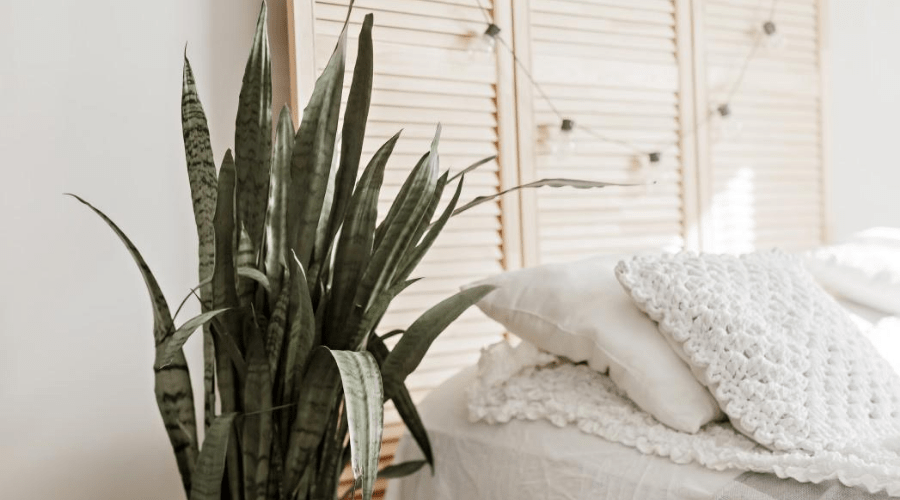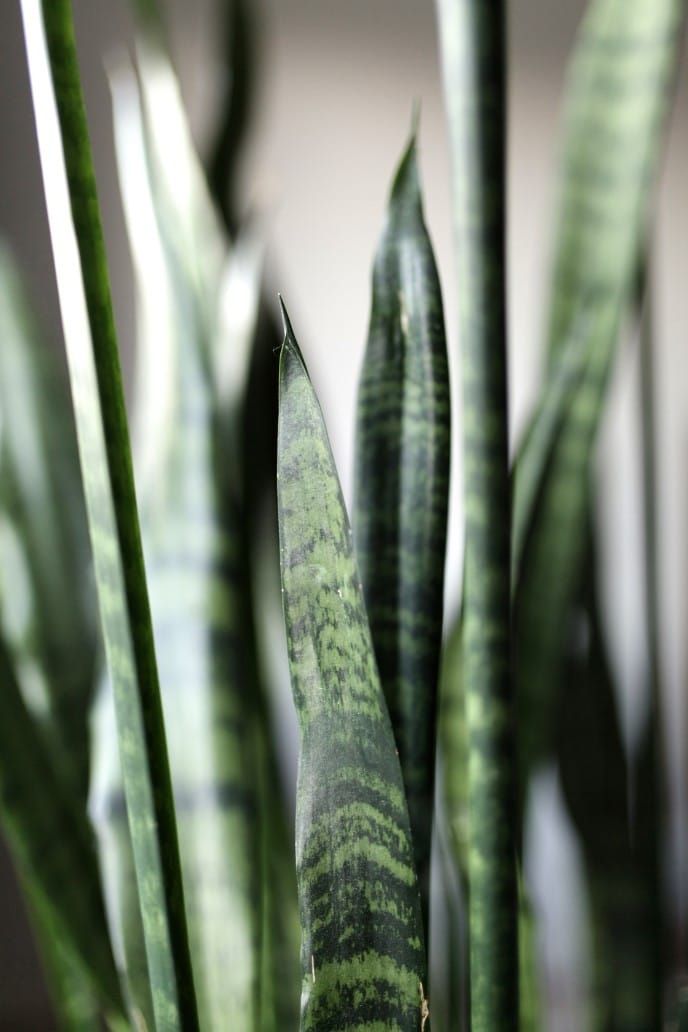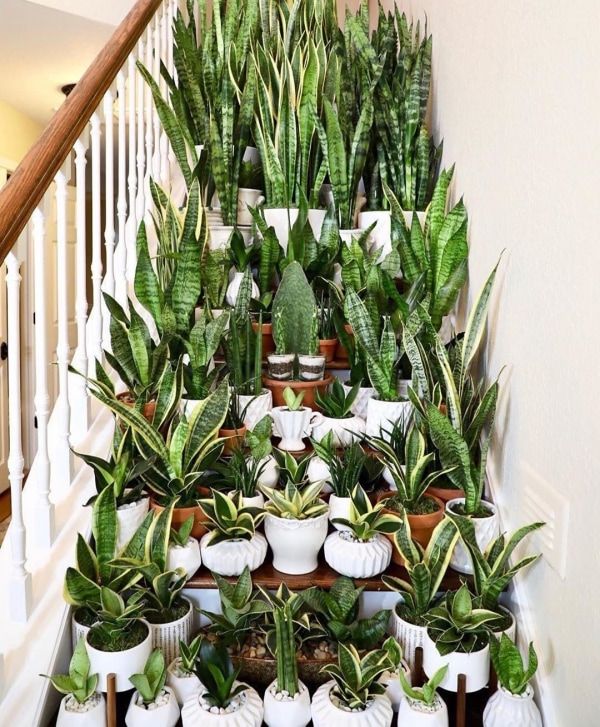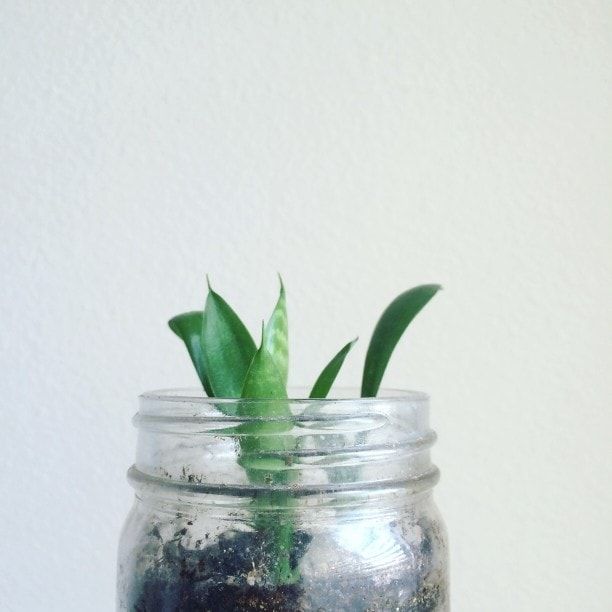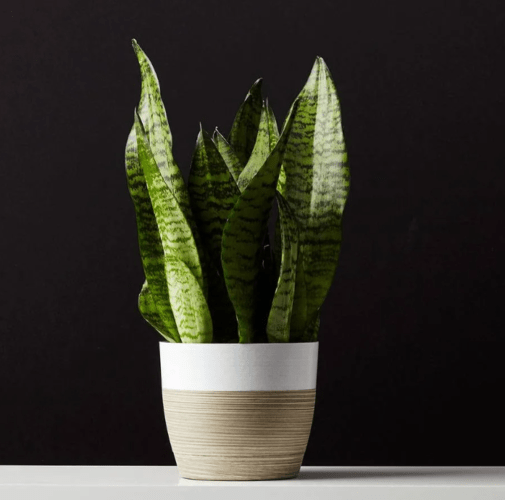Snake plants are beloved by plant enthusiasts and beginner indoor gardeners alike for their wide pattern and leaf variety, easy propagation, low level of care, and extreme air-cleaning abilities. And they look great in any space, too. We've rounded up the best info and care tips for all varieties of sansevieria, including light, water, and fertilizer needs; how to propagate, divide, and prune; and even the best places to buy a snake plant of your own.
Snake Plant Details
Sansevieria spp.
AKA: Mother-in-law's tongue, sansevieria, whale fin, Saint George's sword
Light: very low to bright light
Water: Infrequent, only when soil is very dry
Temperature range: 65-80° F
Height: Up to 48 inches indoors
Fertilizer: Two to three times through spring and summer
Special care: Do not overwater. Wipe dust from leaves at watering. Replace soil and split roots every year or 18 months for maximum growth.
Benefits of Snake Plants
Growing houseplants is gaining widespread popularity, thanks to gorgeous photos on social media and people spending more time in their homes. But it's not only about beautifying your interiors for the 'gram; caring for plants can teach you how to be more responsible, purify your indoor air, and reduce stress levels.
Snake plants are extremely efficient in cleaning the air inside the house against contaminants. The upside to this is that the easy care and low light and water needs of snake plants makes them almost like a passive air filter, since you'll only need to turn the pot and give it a little water every couple of weeks.
Carbon Dioxide: Snake plants are actually really efficient when it comes to the absorption of carbon dioxide. Otherwise, studies have shown that CO2 can impact a person’s cognitive skills and cause them to under perform. Prolonged exposure to carbon dioxide can also cause nausea and dizziness.
Formaldehyde: There are plenty of household activities that trigger the release of formaldehyde, including cooking, using paints, or smoking. When you inhale too much of this substance, you end up with irritated eyes, nose, and throat.
Benzene: There is actually an impressive number of things that can release benzene into the air, including solvents, paints, or even heating and cooling systems. Benzene exposure can lead to vomiting, nausea, and headaches. According to one particular study, a snake plant was able to remove 52.6 percent benzene found in a sealed chamber.
How to Take Care of a Snake Plant
Like most other succulents, snake plants aren’t really that pretentious when it comes to caring for them. There are some basic rules that you have to follow in order to make sure your snake plant lives a full life.
Do Not Overwater Your Snake Plant
This is, in fact, one of the most common mistakes that people make when they try to take care of a snake plant. These can’t thrive in soggy soil, as their roots are very susceptible to rot. With snake plants, you want the soil to dry between waterings. To check that out, you can use something like a wooden chopstick and drive it a few inches into the soil to see if it’s dry.
When you water the plant, do so from the bottom. This will push the roots to grow downward, which results in more stable and thick leaves. Also, make sure you avoid watering the plant too often during the winter, as the plant doesn’t actively grow then.
Regular Sansevieria Maintenance
Snake plants get dusty, perhaps more so than other plants due to their smooth, broad leaves. A plant needs the surface of its leaves to photosynthesize sunlight into food, and to maximize this, they need to be free of dust and debris. Each week or two, wipe all the plant blades with a damp cloth.
Snake plants grow slowly, but as all plants do, they turn toward the light if its unevenly distributed in your space. Every week or two, turn your sansevieria so the light is focused on a new part of the plant and the leaves that may have turned outward can turn back to their upright position. This helps ensure even growth and a more uniform shape of the overall plant.
If your snake plant thrives and grows, you want to make sure to divide it on a yearly basis. This is best done in spring. You can cut out a section that has roots and leaves and replant that in a mixture of well-drained soil.
Snake Plant Varieties
Snake plants come in hundreds of available varieties, some so different in shape or color that they may seem like different plants. Even if the structure of the leaves is quite similar from one variety to another, the colors and shapes are different. Some of the most common snake plant varieties include:
- Sansevieria trifasciata Black Gold is easy to recognize because of its tall leaves that have dark green centers and a light golden edge.
- Sansevieria trifasciata Futura Superba is a smaller version of the Black Gold. It has a similar leaf pattern and the main differences consist of shorter and wider leaves.
- Sansevieria trifasciata Cylindrica is the snake plant variety that’s the most different from all the rest because the leaves have a rounded tubular shape that reminds us of bamboo stalks or aloe vera.
- Sansevieria trifasciata Futura Robusta is the shortest snake plant variety. Its leaves have a silvery green shade and dark green stripes.
Snake Plant Propagation & Growth Rate
Snake plants aren’t just among the easiest plants to take care of, but their propagation is also simple and versatile as there are multiple ways for you to achieve it.
Even if it is not recommended for you to over water the plant because its roots can rot, propagation through water rooting is actually one of the most successful methods.
For this method, you will need a healthy leaf. Pick a pair of sharp shears or scissors to cut it off. You want to choose a container that’s tall enough to hold the leaf. The bottom side of the leaf (the part that has been cut) needs to be placed in sufficient water to cover the bottom quarter.
The container needs to be placed in a spot that avoids direct sunlight, and you have to make sure that you change the water every two days. You should see little roots appear after a week or two. When this happens, plant your new sansevieria into a mix of peat moss and sand or a packaged succulent soil.
You can also propagate snake plants through cutting and the method is similar to the aforementioned water method. The difference is that you cut the leaf and insert it into light moist sand. The roots should then grow in a few weeks.
Where to Buy Snake Plants
Buying snake plants online is no complicated thing, you just have to find the variety you most fancy and for a price that’s most convenient for you. If you’re not sure where to start, here are a few suggestions:
- Houseplant subscription companies such as Bloomscape offer individual plants, as well, most of which come in recycled planters or decorative pots to suit your decor, and these are often much larger, more mature plants than can be found at other retailers.
- Amazon sells excellent, healthy live plants through sellers such as Costa Farms, a company we love for their reasonable prices, wide variety, and healthy, gorgeous plants.
- Through Etsy's marketplace search, an aspiring sansevieria owner can find fully-grown plants, cuttings, and even beautiful planters that would match your future snake plants perfectly.
- You can also choose to buy snake plants directly from growers or stores that are specialized in gardening items and accessories. For instance, Garden Goods has good snake plant offers, alongside a bunch of information that will teach you more about this plant and how to properly grow it.
SNAKE PLANT (SANSEVIERIA)
This sleek Sansevieria with its blade-like leaves is an upstanding plant that will do right by any décor. Easy care, great look, and best of all, snake plants are so good at improving work space air quality that having one in your home can actually cut ventilation needs.
Snake Plants FAQ
Before we go, we wanted to clarify some things and answer some of the most burning questions related to growing a snake plant, so here it goes!
What is the best fertilizer for a snake plant?
In order for a snake plant to thrive, you can use all-purpose plant food during the warmer seasons, as this is when the plant becomes really hungry for nutrients. During the winter, you don’t have to add fertilizer to the plant at all.
What causes snake plants to die?
The most common problem with snake plants is overwatering. When this occurs, the roots of the plant are likely to rot, but that doesn’t mean there’s nothing you can do to save your plant. In fact, snake plants are quite resistant and they can recover from root rot. Should this happen, you can remove the dying leaves and leave the soil to dry out more than usual. If you notice that the plant is not recovering, you can remove it from the pot, cut the rotten roots and leaves, and repot it in a fresh batch of soil.
What are the best light conditions for snake plants?
While snake plants like bright light, they don’t need to be exposed to the sun in order to thrive. They do tolerate some mild sunlight exposure but don’t overdo it. They will grow well in shady spots and even in homes where light is scarce. However, you will need to make sure that the temperature does not fall below 50°F
Can you trim a snake plant?
If it grows too tall and you want to keep the height under control, then yes. For instance, if you have a Sansevieria snake plant and you want to trim it, you can but the tallest leaves all the way down to the soil line. The newest leaves of a snake plant are usually at the center of the rosette and the older ones are at the exterior. This means that you can reduce the height of the plant without interfering too much with the character.
Conclusion
Sansevieria plants come in hundreds of varieties, shapes, and sizes—but universally, they are among the easiest and most beneficial indoor plants to grow. A snake plant is the perfect choice for beginners, for children, and for those who want a plant with beautiful shades of green that requires little upkeep and simple care. With our guide, just a little attention, and annual divisions, you can propagate an entire snake plant jungle from one plant. Or, you can trim and maintain one big, beautiful snake plant for years and years.
We hope this guide has been useful! If you have questions, comments, or would like to see a specific topic for one of our articles, let us know int he comments. Happy indoor gardening!

